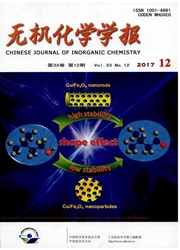

 中文摘要:
中文摘要:
采用碱性条件下的水热法合成了质子钛酸盐纳米管,在此基础上采用化学沉淀方法制备了负载过渡金属(Co,Ni和Cu)氢氧化物的纳米管材料,然后在300℃氩气氛下烧结后得到负载过渡金属(Co,Ni和Cu)氧化物TiO2-B纳米管。采用XRD和TEM等对其结构与形态进行了表征,采用恒电流充放电、循环伏安以及交流阻抗测试研究了其电化学嵌/脱锂性能。结果表明,TiO2-B纳米管通过负载过渡金属(Co,Ni和Cu)氧化物纳米颗粒之后,改善了TiO2-B纳米管的高倍率放电性能和循环稳定性。其中,负载NiO和CuO的TiO2-B纳米管的高倍率放电性能和循环稳定性较为突出。研究还表明,负载过渡金属氧化物纳米颗粒后,有助于保持TiO2-B纳米管在动态反应条件下的拟电容反应控制特征,并不同程度地减小了TiO2-B纳米管的表面电荷转移电阻,这是TiO2-B纳米管的电化学性能改善的主要原因。
 英文摘要:
英文摘要:
The protonated titanate nanotubes were obtained by hydrothermal synthesis, and transition metal hydroxide (Co, Ni and Cu) nanoparticles were then supported on nanotubes. The transition metal oxide (Co, Ni and Cu) nanoparticles supported on TiO2-B nanotubes were obtained subsequently after calcination at 300 ℃ in argon. The obtained products were characterized by XRD, TEM and pore distribution. It is found that transition metal oxide nanoparticles with poor crystallinity are attached to the surface of the TiO2-B nanotubes. The contents of CoO, NiO and CuO in the TiO2-B nanotubes are 4.7wt%, 5.34wt% and 5.74wt% as determined from inductively coupled plasma atom emission spectroscopy(ICP), respectively. The electrochemical lithium intercalation-deintercalation of these nanotubes was studied by galvanostatic method, cyclic voltammetry (CV) and electrochemical impedance spectra(EIS). The TiO2-B nanotubes, supported with NiO and CuO nanoparticles, exhibit the optimal cycle performance and high rate discharge capability, as compared with TiO2-B nanotubes. In addition, it is also demonstrated that pseudocapacitive effect is dominant for all nanotubes and the charge transfer resistance is decreased obviously for TiO2-B nanotubes with the supporting of NiO and CuO nanoparticles, which is beneficial for the improvement of the high rate charge-discharge capability.
 同期刊论文项目
同期刊论文项目
 同项目期刊论文
同项目期刊论文
 期刊信息
期刊信息
